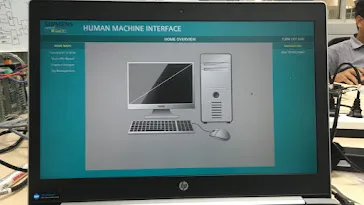
Enhancing Efficiency and Safety: The Power of HMI Software. HMI software is an amazing computer program that changes how humans interact with machines. It has a user-friendly interface and allows people to control machines and systems easily. Industries like manufacturing and automation use HMI software for real-time monitoring and operation.
It offers features like data visualization, alarms, and remote monitoring. When choosing an HMI software vendor, consider reliability, functionality, scalability, user-friendliness, support, compatibility, and security. HMI software unlocks great possibilities and gives you more control over your machines.
Read Also: Industrial HMI Software
The Power of HMI Software
HMI software, also known as Human-Machine Interface software, is a computer program designed to facilitate communication between humans and machines. It typically consists of a graphical user interface (GUI) that displays data and allows users to interact with a machine or system.
HMI software is commonly used in various industries such as manufacturing, automation, and process control. It enables operators to monitor and control machines or processes in real time, providing them with critical information and allowing them to make adjustments as needed.
The features and capabilities of HMI software can vary depending on the specific application and industry requirements. Some common functionalities include data visualization, alarms and event notifications, historical data logging, remote monitoring and control, and integration with other systems or databases.
HMI software plays a crucial role in enhancing operational efficiency, improving productivity, and ensuring safety in industrial environments. It allows operators to quickly and intuitively interact with complex systems, enabling them to monitor performance, diagnose issues, and optimize processes.
HMI software serves as a vital tool in enabling effective human-machine interaction, making it an essential component in many automated and industrial systems.

HMI (Human-Machine Interface) software is an essential tool for businesses across various industries. It allows operators to interact with machines, systems, and processes through intuitive graphical interfaces.
However choosing the right HMI software vendor can be a daunting task. With so many options available in the market, it’s important to carefully evaluate and compare different vendors before making a decision.
How to Choose the Best HMI?
When selecting an HMI software vendor, consider the following factors:
- Reliability: Look for a vendor with a solid track record and positive customer feedback. Check if they have been in the industry for a significant period and if they have a good reputation for delivering reliable solutions.
- Functionality: Assess the features and capabilities of the HMI software. Ensure that it meets your specific requirements and supports the necessary communication protocols for your equipment. Look for features like data visualization, alarm management, historical data logging, and remote access.
- Scalability: Consider your future needs and growth plans. Choose a vendor whose software can easily scale along with your business requirements. This will save you from the hassle of switching vendors or upgrading to a different solution in the future.
- User-Friendliness: A user-friendly interface is crucial for efficient operation and reduced training time. Check if the vendor provides intuitive design tools and customization options to tailor the interface to your specific needs.
- Support and Maintenance: Ensure that the vendor offers reliable technical support and regular software updates. Check if they have a dedicated support team and a well-defined process for issue resolution.
- Compatibility: Make sure the HMI software is compatible with your existing infrastructure and integrates seamlessly with other systems, such as PLCs (Programmable Logic Controllers) and SCADA (Supervisory Control and Data Acquisition) systems.
- Security: In today’s interconnected world, security is of paramount importance. Evaluate the security measures implemented by the vendor, such as user authentication, data encryption, access control, and audit trails.
By considering these factors and conducting thorough research, you can find an HMI software vendor that aligns with your business goals and provides a robust and user-friendly solution. Remember, choosing the right HMI software vendor can significantly impact the efficiency and productivity of your operations, so take your time and make an informed decision.
Discover more from Sugeng Riyanto
Subscribe to get the latest posts to your email.
You must be logged in to post a comment.